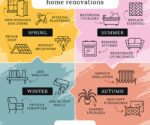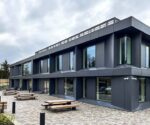‘Giving light to the indoor generation ’
 Living in damp and mouldy homes increases our risk of asthma by 40%, and unless we act now we risk endangering our health as a result. Research from the Velux Group has revealed the need to rethink building design and renovation to avoid a future increase of children suffering from asthma or allergies. The Indoor Generation survey was conducted across 14 countries (including the UK), unveiling around 16,000 people’s perceptions of the way they live their lives and what contributes to their personal health. The survey unearthed an alarming misconception that the vast majority of people in Britain (62%) believe indoor air is just as polluted or cleaner than outdoor air. It also revealed a lack of understanding about the importance of adequate natural ventilation. Dr Russell Foster, Head of the Nuffield Laboratory of Ophthalmology and the Sleep and Circadian Neuroscience Institute, University of Oxford, said: “From the year 1800 to 2000, we’ve gone from 90% of people working outside to less than 20%. In a very short space of time, we’ve gone from being an outdoor species to spending most of our time in dim, dark caves.”
Living in damp and mouldy homes increases our risk of asthma by 40%, and unless we act now we risk endangering our health as a result. Research from the Velux Group has revealed the need to rethink building design and renovation to avoid a future increase of children suffering from asthma or allergies. The Indoor Generation survey was conducted across 14 countries (including the UK), unveiling around 16,000 people’s perceptions of the way they live their lives and what contributes to their personal health. The survey unearthed an alarming misconception that the vast majority of people in Britain (62%) believe indoor air is just as polluted or cleaner than outdoor air. It also revealed a lack of understanding about the importance of adequate natural ventilation. Dr Russell Foster, Head of the Nuffield Laboratory of Ophthalmology and the Sleep and Circadian Neuroscience Institute, University of Oxford, said: “From the year 1800 to 2000, we’ve gone from 90% of people working outside to less than 20%. In a very short space of time, we’ve gone from being an outdoor species to spending most of our time in dim, dark caves.”
What makes a healthy home
We know from previous research that Europeans consider the quality of their home environment to be more important than a healthy diet or being physically active, yet the new YouGov survey uncovers an alarmingly low level of knowledge of what makes a healthy home. Jim Coates, Director at Velux, said: “Public buildings are just as important to consider as homes. Many offices have been designed with windows which do not open, leading to ‘sick building syndrome’ where carbon dioxide and viruses remain trapped in buildings with no means of escape. And whilst there is compelling research which demonstrates the positive impact which both daylight and ventilation has on exam results, for example, there is no clear legislation to influence change for the better. “It was recognised in the legal framework for buildings, adopted on 17 April by the European Parliament, that all technical building systems shall be designed in a way so that they optimise health, wellbeing and indoor comfort. But we need to go further to promote the holistic building approach. “The health benefits of improving our indoor environment are scientifically proven, however we still have a long journey to go on in terms of making people understand that these changes are not just a ‘nice to have’. Without action we can put our health at risk.”
The YouGov survey revealed that most people underestimate the amount of time they spend indoors, with a quarter of people (25%) claiming to spend just 14 hours or less inside. We know, in reality that the majority spend over 90% of their time indoors, and often in dark, poorly ventilated buildings leading to the emergence of a so called ‘indoor generation’. Almost one in four people (23%) admitted to never going outside, spending up to 24 hours a day indoors. The Indoor Generation refers to a growing number of people who spend the vast majority of their time indoors – currently 90% of their lives – compared to previous generations. Jim continued: “What the research reveals is that we cannot ignore the health of our indoor domestic and public spaces. Given the vast amount of time which we all spend indoors, the levels of pollutants adults and children can be exposed to on a daily basis is worrying. In recent years the trend has been towards making our buildings more energy efficient, however, the unintended consequence is that we’re trapping pollution within our buildings.
The solution is very simple
“The solution is really very simple, but in order to have impact there needs to be a change in mind-set when it comes to building design. For too long we’ve prioritised energy efficiency but overlooked human health factors. “We want to encourage architects and those conducting home renovations to put human and basic health needs centre stage and limit the number of people affected by living in unhealthy buildings. We believe the best way to do this is by raising awareness of the many small changes that everyone can make which can have a real impact on air quality, and ultimately health. Making such changes will have a positive impact on Gross Domestic Product (GDP) as a result of improved attendance rates, both at school and at work, and fewer medical appointments.” Dr Hilary Jones GP & Health Broadcaster said: “The rapid change in our lifestyle from spending large amounts of time outdoors for work or relaxation to becoming an Indoor Generation carries with it several risks, not least when it comes to health in dark, poorly ventilated homes. Poor ventilation can lead to damp or mould in the home, and can trigger asthmatic symptoms – and it is worrying that the most polluted rooms tend to be the children’s – with asthma more common in younger people. “Right now, more than five million people in the UK have asthma, the majority of which are children, and more than 20% of the UK will at one time in their life have a long-term lung condition, such as Chronic Obstructive Pulmonary Disease (COPD). “Equally we must make sure that we’re getting the light exposure that we need in order to protect our immune systems. Many of us do not realise that lack of light can affect our sleep patterns and in turn increase our risk of health problems such as diabetes, heart disease and depression.
Impact of lifestyle choices
“We don’t want to alarm people – instead we want them to be aware of the impact our lifestyle choices are making and help them to make simple changes for the better. There are small steps to make the air inside your home or office healthier, such as opening windows to allow fresh air in, particularly when bathing or cooking and cleaning regularly to keep allergens – such as dust mites – in check. “And when it comes to daylight – the best tonic is to get outside and expose ourselves to natural daylight on a daily basis, if this isn’t possible then try to sit by the window when indoors. Not only will this lift your mood but it will also help you to sleep better, which leads to enhanced concentration and improved general health and immunity.” By sharing the survey, Velux hopes to raise awareness of the importance of designing healthy buildings that are well ventilated and enjoy both good daylight and fresh air. In the longer-term Velux would like to urge architects and planners to prioritise ventilation and light from the very start when retrofitting or designing buildings or city planning. The top tips below can be provided as guidance to customers who are planning a renovation or new build – be it domestic or commercial – and follow the principles of the Circadian House. They should understand the importance of: • Fresh air ventilation – the importance of airing your home three to four times a day, including the placement of windows at different heights • The importance of daylight in the home – for example re-designing the home to ensure the rooms you use the most are south facing • Limiting sources of damp or moisture indoors • Ensuring carpets are cleaned – or better still get rid of them .
www.velux.co.uk/indoorgeneration
Indoor Generation video at: https://youtu.be/ygHU0mQGuJU











